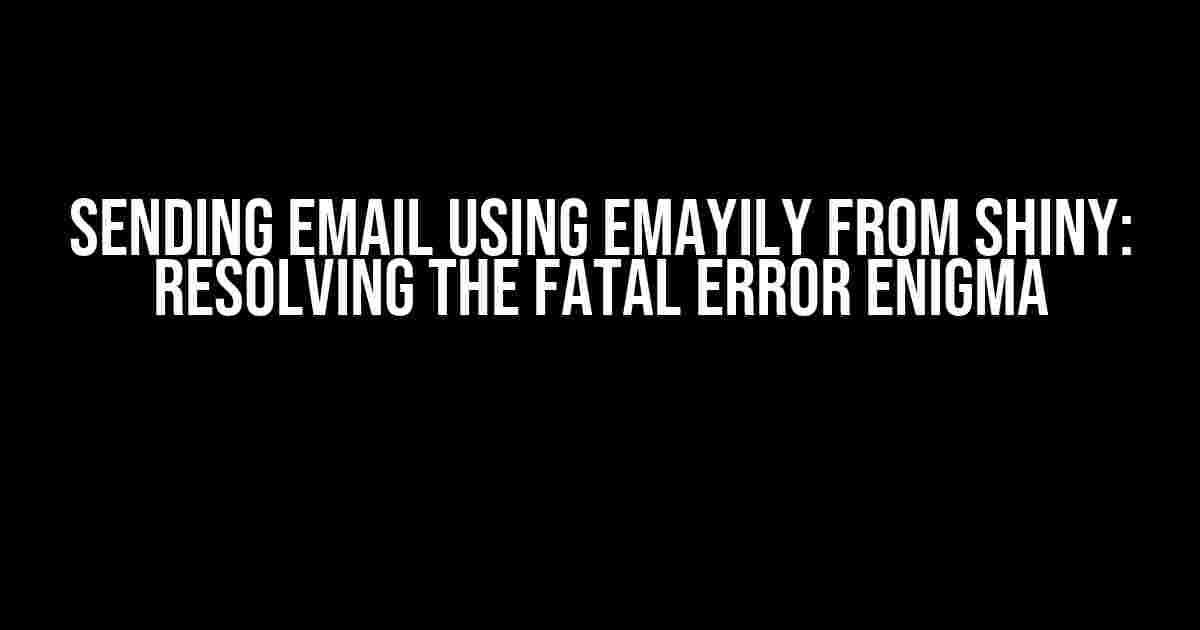Are you tired of encountering the frustrating “fatal error and abort” message when trying to send emails using Emayily from your Shiny application? You’re not alone! Many R enthusiasts have stumbled upon this obstacle, only to find that the same code works flawlessly when executed as a standalone R script. In this article, we’ll delve into the mysteries of this error, explore the possible causes, and provide a step-by-step guide to help you overcome this hurdle and successfully send emails using Emayily from your Shiny app.
Understanding the Problem: Why Emayily Fails in Shiny
Before we dive into the solution, it’s essential to understand why this error occurs in the first place. There are a few possible reasons why Emayily might fail to send emails from your Shiny application:
- Lack of email authentication: Emayily requires authentication to send emails, which might not be properly configured within your Shiny app.
- Incompatible R versions: Ensure that the R version used in your Shiny app is compatible with the Emayily package.
- Missing dependencies: Emayily relies on certain dependencies, such as the
sendmailRpackage, which might not be installed or loaded correctly. - Permissions and access control: Your Shiny app might not have the necessary permissions to access the email server or send emails.
Step-by-Step Solution: Sending Emails using Emayily from Shiny
Now that we’ve identified the potential causes, let’s follow a step-by-step guide to resolve the issue and successfully send emails using Emayily from your Shiny application:
Step 1: Install and Load Required Packages
Make sure you have the necessary packages installed and loaded in your R environment:
install.packages("Emayily")
install.packages("sendmailR")
library(Emayily)
library(sendmailR)Step 2: Configure Email Authentication
Set up email authentication using the emayily_configure() function:
emayily_configure(
username = "your_email_username",
password = "your_email_password",
hostname = "your_email_hostname",
port = 587,
tls = TRUE
)Step 3: Create a Shiny App with Email Functionality
Create a new Shiny app with a UI and server function:
library(shiny)
# UI function
ui <- fluidPage(
textInput("email_to", "Recipient's Email:"),
textInput("email_subject", "Email Subject:"),
textAreaInput("email_body", "Email Body:"),
actionButton("send_email", "Send Email")
)
# Server function
server <- function(input, output) {
observeEvent(input$send_email, {
# Send email using Emayily
emayily_send(
to = input$email_to,
subject = input$email_subject,
body = input$email_body,
from = "your_email_address"
)
})
}
# Run the application
shinyApp(ui = ui, server = server)Step 4: Run the Shiny App and Send Emails
Run the Shiny app and enter the recipient’s email, subject, and body. Click the “Send Email” button to send the email using Emayily:
Troubleshooting Tips and Best Practices
While following the above steps should resolve the “fatal error and abort” issue, here are some additional tips to ensure a smooth email sending experience:
- Use a valid email address: Ensure that the email address used in the
emayily_configure()function is valid and has the necessary permissions to send emails. - Check email server settings: Verify that your email server settings are correct, including the hostname, port, and TLS settings.
- Test email sending: Test the email sending functionality in a standalone R script before integrating it into your Shiny app.
- Monitor email sending logs: Keep an eye on email sending logs to identify any potential issues or errors.
- Use error handling: Implement error handling mechanisms to catch and display any errors that may occur during email sending.
Conclusion
Sending emails using Emayily from your Shiny application shouldn’t be a daunting task. By following the steps outlined in this article, you should be able to resolve the “fatal error and abort” issue and successfully send emails. Remember to configure email authentication, load required packages, and test email sending functionality in a standalone R script. With these tips and best practices, you’ll be well on your way to creating a seamless email sending experience in your Shiny app.
Happy coding, and happy emailing!
Frequently Asked Question
Are you stuck with sending emails using emayily, from shiny, and get a fatal error and abort? Worry not, we’ve got the answers for you!
Why does sending email using emayily from Shiny result in a fatal error and abort?
This is likely due to Shiny’s parallel processing nature, which can cause issues with email sending. Shiny is designed to handle multiple requests simultaneously, and emayily might not be able to handle this concurrent access, leading to a fatal error and abort.
Why does sending email using emayily from an R script work fine?
When you run an R script, it executes sequentially, and emayily can handle the email sending process without any issues. In contrast, Shiny’s parallel processing can cause concurrency problems, leading to the fatal error and abort.
How can I troubleshoot the email sending issue in Shiny?
To troubleshoot, try sending the email using emayily in a non-parallel environment, such as an R script. If it works, then the issue is likely related to Shiny’s parallel processing. You can also try using other email sending packages, like mailR or sendmailR, to see if they exhibit the same issue.
Is there a workaround to send emails from Shiny using emayily?
Yes, one possible workaround is to use a queueing system, like RabbitMQ, to handle the email sending process. This allows you to decouple the email sending from Shiny’s parallel processing, reducing the likelihood of concurrency issues.
What are some alternative email sending packages for Shiny that don’t have concurrency issues?
You can try using mailR, sendmailR, or blastula, which are designed to handle email sending in Shiny applications. These packages are more robust and can handle the parallel processing nature of Shiny, reducing the likelihood of concurrency issues.
